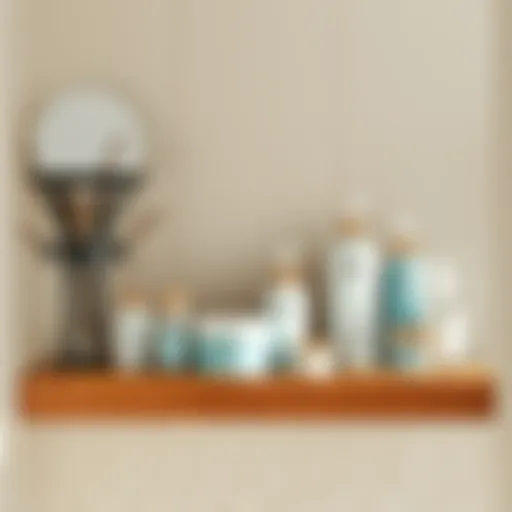Elevate Your Bedroom with Light Purple Paint
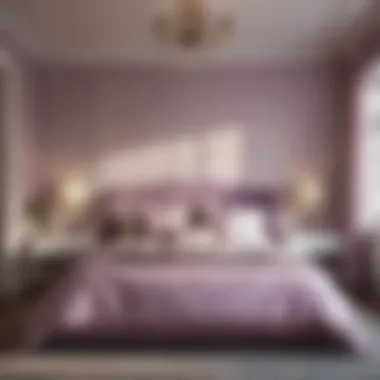

Intro
Exploring the use of light purple paint in bedroom design opens a doorway to creating a serene personal space. The essence of light purple, often associated with calmness and tranquility, can significantly influence the mood and ambiance of a room. This article examines various dimensions of using light purple paint, including its aesthetic appeal and psychological characteristics.
Light purple exists on a spectrum, ranging from pastel lavender to more vibrant tones. Each shade carries a distinct atmosphere and feeling, inviting an array of design possibilities. Homeowners and design enthusiasts alike can benefit from understanding how to integrate this color thoughtfully into their bedroom spaces.
Design Inspirations
Trending Styles
Light purple paint is gaining traction in modern interior design. From minimalistic aesthetics to bohemian styles, it can adapt and enhance various themes. Here are some noteworthy styles utilizing light purple:
- Scandinavian: The muted tones of light purple can complement the airy feel of Scandinavian design. It supports natural light and keeps the space feeling spacious.
- Contemporary: Light purple adds a soft touch to sleek, modern designs without overwhelming the sophistication.
- Vintage Shabby Chic: Paired with white or wooden accents, light purple creates an inviting vintage atmosphere that feels cozy and nostalgic.
Color Palettes
When working with light purple, pairing it with complementary colors is essential to achieving balance in a room. Suitable palettes can include:
- Light Gray and White: This combination promotes a soft, serene look.
- Mint Green: This pairing adds fresh energy and contrast while still maintaining a calm vibe.
- Warm Neutrals: Beige and tan can soften light purple's coolness, creating a comforting ambiance.
Product Recommendations
Bath Accessories
Incorporating light purple into bathroom accessories can enhance the theme, providing cohesion throughout the home. Consider these items:
- Towels: Soft, plush towels in light purple.
- Shower Curtains: A light purple curtain can set the tone for a relaxing bath experience.
- Decorative Baskets: Use wicker or fabric baskets in complementary shades to store toiletries and towels.
Bedroom Essentials
These essential items can be thoughtfully selected to enhance the light purple theme in a bedroom:
- Bedding: Light purple sheets paired with neutral comforters foster a restful environment.
- Curtains: Sheer light purple curtains can diffuse natural light beautifully, creating a gentle glow.
- Accent Pillows: Pillows in various shades of purple can add depth and visual interest to the overall design.
In summary, light purple paint offers an incredible opportunity to personalize a bedroom while promoting relaxation and comfort. Careful consideration of design styles and color palettes can elevate the aesthetic and emotional qualities of the space.
Intro to Light Purple in Interior Design
In recent years, light purple has emerged as a prominent choice in interior design, particularly in bedroom settings. This hue, often considered a blend of tranquility and creativity, can transform a personal space into a serene retreat. Understanding its significance involves examining various elements that influence our perceptions and feelings. The emotional and aesthetic effects of color must not be overlooked as they serve both practical and psychological purposes in how we design our living environments.
The choice of light purple in a bedroom can create an ambiance that promotes relaxation and calmness. It is essential to recognize this color not only for its visual appeal but also for its capacity to evoke feelings of peace. Color psychology plays a critical role when selecting tones that foster the desired atmosphere. In bedrooms, where comfort and rest are paramount, light purple can be particularly effective.
Moreover, incorporating light purple into bedroom design comes with its set of considerations. These include the alignment of color with existing decor, the brightness of the space, and how light interacts with the paint over different times of the day. Since a bedroom is often a personal sanctuary, the choice of color will reflect the occupant’s tastes and lifestyle.
"Color is a power which directly influences the soul." — Wassily Kandinsky
In summary, recognizing the value of light purple in bedroom design allows for a considered approach to creating an inviting personal space. It brings into focus the relationship between color and atmosphere, setting the stage for the following sections that delve deeper into understanding color psychology and the specific nuances of light purple as a design choice.
Understanding Color Psychology
Color psychology is the study of how colors affect emotions and behaviors. In the context of interior design, understanding this relationship is crucial. Light purple, associated with calmness and creativity, can inspire feelings of serenity. This hue promotes a peaceful environment, making it suitable for bedrooms where restfulness is key. Research indicates that softer colors like light purple can reduce stress levels. Homeowners looking to enhance their personal spaces should consider this psychological aspect when selecting colors.
Light purple is also linked to feelings of nostalgia and gentleness. Incorporating such a color can help create a space that feels both comfortable and inviting. In bedrooms, these factors can lead to enhanced emotional well-being and a more restful environment.
Light Purple as a Design Choice
As a design choice, light purple offers versatility. It can stand alone as the primary color or blend well with various palettes. This hue complements neutral colors, such as whites, grays, and beiges, providing a soft contrast. Consequently, the use of light purple can enhance the overall aesthetic while maintaining a calm atmosphere.
Additionally, light purple can serve as a backdrop for bolder accents. Bright accessories or furniture can pop against a light purple wall without overwhelming the senses. This balance encourages creativity without sacrificing comfort, making it an ideal selection for bedrooms where functionality meets style.
When choosing light purple paint, homeowners should consider factors such as the size of the room and natural light sources. A small room can benefit from lighter shades, making it appear larger and more open, while larger spaces can utilize darker iterations to create warmth and depth. Understanding these nuances is critical for anyone looking to implement light purple into their bedroom design effectively.
Varieties of Light Purple Paint
When considering light purple paint for bedroom design, it is crucial to understand the various shades available. Each variety of light purple carries its unique characteristics, influencing not only the aesthetic but also the mood of the space. Selecting the right shade can greatly enhance the overall ambiance and comfort of a bedroom. The subtleties among the different tones allow for customization that aligns with personal taste, contributing to a calming and inviting environment.
Lavender: The Classic Choice
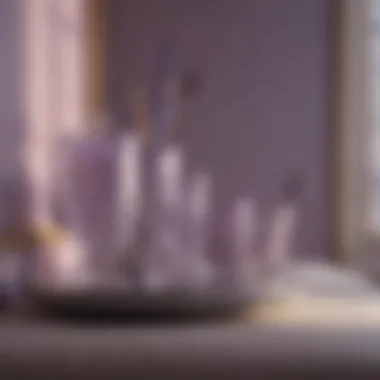

Lavender is a timeless option when it comes to light purple paint. With its soft, muted tone, it provides a classic touch that many homeowners appreciate. Lavender often evokes a sense of nostalgia, bringing with it a feeling of warmth and serenity. This shade is particularly beneficial in bedrooms where relaxation is key. It balances well with both light and dark furnishings, making it a versatile choice for various decor styles.
Moreover, lavender can improve mood, creating a peaceful retreat. This makes it appealing for those looking to unwind after a long day. It is advisable to test the shade in different lighting conditions, as it can appear lighter or darker depending on the time of day.
Lilac: Soft and Subtle Shades
Lilac presents an even softer alternative to lavender. It embodies delicate hues that exude calmness, making it an excellent option for spaces intended for rest and rejuvenation. Lilac pairs beautifully with whites and greys, generating an airy feeling. This subtle shade tends to promote a gentle atmosphere, conducive for a serene bedroom environment.
Applying lilac paint can transform a room. It helps create a harmonious balance with nature, especially when combined with green plants or other soft-toned textiles. Lilac is often associated with tranquility and has implications of comfort, making it favorable for families seeking to enhance their personal spaces.
Plum: Depth in Light Tones
Plum, while often classified as a darker hue, can also appear in lighter tones that offer depth without overwhelming a space. Its richness brings a luxurious feel to a bedroom, allowing homeowners to make bold yet sophisticated choices. Plum can be used to create a focal wall, providing an accent in an otherwise subdued palette. This shade enhances the room's character, introducing a cozy atmosphere.
Consider plum for spaces where more dramatic flair is desirable. It works exceptionally well with metallic accents such as golds and silvers, establishing a chic environment. Utilizing plum effectively can result in a sophisticated and inviting bedroom that reflects personal style.
"Choosing the right variety of light purple paint is a crucial step in designing a bedroom that not only looks appealing but also nourishes the spirit."
Selecting the Right Shade
Choosing the right shade of light purple for your bedroom is a crucial step in ensuring the space reflects both your personal style and provides an inviting atmosphere. The soft hues of light purple can transform a room into a sanctuary of relaxation. However, it is essential to consider various elements when selecting the shade. These include evaluating natural light, understanding undertones, and testing paint samples.
Evaluating Natural Light
Natural light affects how colors appear in any room. It is vital to observe how light interacts with surfaces throughout the day. In a room with plenty of natural light, lighter shades of purple will appear more vibrant and airy. However, the same shade may look muted in a dimly lit environment. Windows orientation also plays a role. South-facing rooms receive warm light, enhancing warmer undertones in light purple, while north-facing rooms may cast a cooler effect. Using these observations, homeowners can better decide which shades will be most suitable for their specific conditions.
Understanding Undertones
Undertones in paint can be tricky, yet they significantly influence the mood of the空间. Light purple tones can range from warm pinkish tones to cool blues. Identifying the undertones relevant to a particular shade can help matters. For example, a light purple with a blue undertone can offer a calm, tranquil vibe, perhaps ideal for bedrooms. In contrast, a warmer, pink-inflected light purple can feel more inviting and cozy. It is advisable to assess the undertones in different lighting conditions before making a final choice, as they can shift quite noticeably.
Testing Paint Samples
Once potential shades have been narrowed down, painting samples on the wall is an essential next step. Small color patches give a real sense of how the color integrates into the room. It is important to apply samples in several areas since wall textures can affect color perception. It is also wise to observe the samples at different times of the day, under both natural and artificial light. This direct comparison helps in uncovering any surprises, ensuring the selected shade harmonizes well with the overall design while also meeting the aesthetic vision of the room.
Selecting the right shade of light purple is not just about preference; it is about creating an atmosphere that enhances comfort and aesthetics in a bedroom.
Complementary Color Palettes
Choosing the right complementary color palette is essential when working with light purple paint in bedroom design. A carefully selected palette enhances the overall aesthetics of the room while creating a harmonious environment. Colors interact in ways that can either elevate or detract from the space's tranquility. Light purple, with its soothing qualities, pairs effectively with various complementary colors that help to define the ambiance of a bedroom.
When considering complementary colors, there are a few important elements to keep in mind. Light purple is versatile and can serve as a foundation from which to build. It often works with both warm and cool tones, allowing for diverse styling options, which is beneficial when designing personalized spaces.
Neutral Colors as Foundations
Neutral colors are a solid choice as they can balance light purple's soft charm. Shades like beige, gray, and white can provide a clean, uncluttered backdrop that allows light purple to shine without overwhelming the senses.
- Beige: This warm tone adds softness, creating a welcoming feeling in the room.
- Gray: A cooler gray can offer a modern touch while keeping the overall look serene.
- White: Classic and timeless, white enhances light purple’s brightness, making it feel airier.
These neutral foundations can also be easily accessorized, enabling further personalization of the space without complicating the overall design.
Contrasting Colors that Enhance
In addition to neutrals, contrasting colors can enhance light purple magnificently. The right contrasts can create focal points and provide visual interest. Darker shades of blue or even rich greens can create depth alongside light purple.
- Navy Blue: This deep color adds sophistication and works wonderfully for accents, such as bedding or curtains.
- Forest Green: A natural, earthy contrast that brings a sense of calm and environment.
Using these colors in moderation allows light purple to remain the primary focus while drawing attention to key features in the room.
Textures and Patterns
Complementary color palettes should not only consider flat colors but also incorporate textures and patterns. This approach enhances the visual complexity of a space, making it more engaging.
- Fabrics: Textiles like wool, silk, or cotton in different colors can give depth to light purple.
- Wall Patterns: Geometric or floral wallpapers in contrasting colors can add character without overshadowing light purple.
- Textures: Combining matte and glossy finishes, such as a matte wall with glossy furniture, can create visually appealing contrasts while maintaining harmony.
A thoughtfully curated palette, with a mix of colors, textures, and patterns, brings out the best in light purple paint, allowing the bedroom to become a serene sanctuary.
Application Techniques for Painting
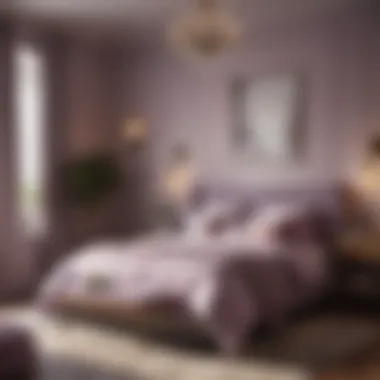

Applying light purple paint in a bedroom involves several key techniques to ensure a smooth and attractive finish. Understanding these techniques not only enhances the aesthetic appeal but also extends the life of the paint job. The quality of the application can significantly affect the overall look of the room, making it essential to master the right methods to achieve a professional outcome.
Preparation of Surfaces
Before painting, surface preparation is crucial. This step can not be overlooked. Start by cleaning the walls to remove dust, grease, or any residue. A damp cloth is often enough for this task. After cleaning, fill in any holes or cracks with a suitable filler. Sanding these areas smooth is necessary for a clean finish. Ensure the wall is dry before proceeding. Any imperfections will be noticeable once the paint is applied, detracting from the overall appearance. Proper preparation sets a solid foundation for the paint.
Choosing the Right Finish
The finish of the paint also plays a significant role in the final look. Different finishes reflect light in distinct ways, affecting how the light purple hue appears throughout the day. Typical finishes include matte, eggshell, satin, semi-gloss, and gloss.
- Matte finish is non-reflective and good for hiding imperfections, but it may not be the best choice for high-traffic areas.
- Eggshell and satin finishes strike a balance between gloss and matte, making them versatile for bedrooms where durability is desired without excessive shine.
- Semi-gloss and gloss finishes are ideal for trim and moldings, where a bit of shine can enhance the design.
Consider both the aesthetic and functional aspects when choosing the finish.
Techniques for Smooth Application
Achieving a smooth application requires care and attention. Start by using the right tools, such as high-quality brushes and rollers. For painting large areas, rollers are efficient, while brushes help in corners and edges. Here are some tips to keep in mind:
- Load the brush or roller evenly. This prevents drips and allows for a more uniform layer of paint.
- Use long, even strokes. This technique helps in distributing the paint evenly across the surface.
- Work from top to bottom. Start from the ceiling and work your way down to avoid drips on freshly painted areas.
Additionally, consider painting in sections. Finish one section before moving on to the next to ensure you can blend edges easily.
"Preparation and technique are as vital as the paint itself. Invest time in these areas for a lasting finish."
By focusing on preparation, choosing the right finish, and employing effective application techniques, homeowners can transform their bedrooms with light purple paint successfully. This attention to detail not only enhances visual appeal but also contributes to a more relaxing and inviting atmosphere.
Incorporating Furniture and Accessories
Incorporating the right furniture and accessories into a bedroom painted in light purple is essential for achieving a harmonious and inviting space. Furniture selection plays a crucial role in establishing the overall vibe of the room. Complementary pieces enhance the calming nature of light purple while offering functionality. Homeowners should consider how textures, colors, and styles work together to complete the design narrative.
In design, furniture acts as a foundation. Each piece must not only serve a purpose but also resonate with the chosen color palette. Accessories serve to accentuate and provide depth to the room. Careful consideration of these elements helps craft a cohesive and sophisticated atmosphere.
Furniture Choices that Complement Light Purple
Choosing furniture for a light purple room can dictate how the space feels. Lighter woods like maple or birch can maintain the soft environment, while darker woods, like walnut, can create a striking contrast in a sophisticated manner.
- Neutral Tones: Opt for pieces in beige, gray, or white to let the light purple pop. Such choices maintain a subtle elegance.
- Pastel Shades: Softer pastels blend well. Consider'soft green or light blue accents. They harmonize without overpowering.
- Materials: Consider light fabrics. Linen or cotton in neutral shades provides comfort. If pursuing a more luxurious look, velvet in soft tones may be suited.
The arrangement of furniture also matters. It’s vital to create balance in the space so that large pieces do not overwhelm the lightness of the purple walls.
Textiles and Fabrics
Textiles are another important consideration. They can transform a room in both appearance and comfort. Soft textiles contribute significantly to mood creation in a light purple bedroom.
- Bedding: Choose bedding that combines various shades of purple or contrasting colors for visual interest. Soft, breathable materials enhance relaxation.
- Curtains: Light, sheer curtains can soften the daylight. They also create a dreamy atmosphere when paired with thicker drapes in complementary colors.
- Rugs: A rug can ground the space. Select one that reflects the color palette, providing warmth underfoot and adding texture.
Integrating textures such as knits or woven designs through pillows and throws can add depth to the theme. These not only elevate aesthetic appeal but also enhance comfort, creating a snug retreat.
Artwork and Decor Suggestions
Artwork and decor add the finishing touches to a space. Select pieces that evoke personal expression while maintaining design integrity. Focus on options that enhance the soothing appeal of light purple.
- Wall Art: Choose larger statement pieces in complementary colors. Abstract or floral designs can create movement while resonating with the color scheme.
- Framed Pictures: Personal photographs in soft-toned frames add a personal touch, providing warmth and familiarity.
- Accessories: Decorative items like vases or sculptures in white, gold, or muted colors can act as focal points. Green plants bring natural elements into the space, echoing the serenity light purple embodies.
In summary, furniture and accessories play pivotal roles in establishing an inviting bedroom atmosphere. Mindful selection and placement can enhance not only the visual but also the overall experience of the space.
Mood and Ambiance Considerations
The significance of mood and ambiance cannot be understated when it comes to bedroom design. This space serves as a sanctuary for relaxation, romance, and rejuvenation. Therefore, the colors and elements you choose for your room can directly influence your mental and emotional states. Light purple paints have unique qualities that can help create a soothing and graceful atmosphere. It’s vital to consider how the choices made will affect the overall energy of the room.
Creating a Relaxing Atmosphere
Light purple sets a serene foundation in a bedroom, fostering a calming environment. When used on walls, this color can evoke feelings of tranquility and comfort. Many people experience a psychological response to colors, where lighter tones often create an impression of openness and peace. Choosing light purple encourages a gentle vibe, ideal for winding down after a hectic day. Accessorizing this hue with soft bedding and minimal distractions enhances the calming effect, allowing the space to feel like a true refuge.
Impact on Sleep Quality
Recent studies suggest the color of a room can affect sleep quality. Light purple promotes a peaceful ambiance, which can help with relaxation before sleep. When combined with adequate lighting, it helps signal your body to wind down. Darker and more saturated colors can stimulate the brain, while softer shades like lavender can promote a sense of safety and comfort. By enhancing the sleep environment, light purple could be a key component in ensuring you experience deeper, more restorative rest at night.
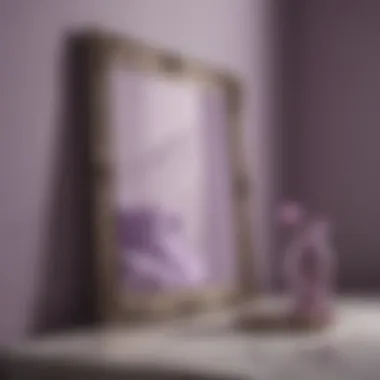

Enhancing Personal Space
Personalization in a bedroom is essential for reflecting one's unique identity and preferences. Light purple serves as a versatile back-drop, accommodating a range of personal styles. It tends to complement various accessories, from artwork to furniture. This adaptability makes it easy to incorporate personal touches through decorative elements. By adding contrasting accents or contrasting textures, light purple becomes a canvas that brings personal elements to life. This allows each individual to cultivate a bedroom atmosphere that resonates with their personal idea of solace and comfort.
"Color affects not only how spaces look, but how we feel and interact within them. Choosing wisely is crucial."
Case Studies in Bedroom Transformations
Case studies provide valuable insights into the practical application of light purple paint in real-world settings. They showcase how various spaces have been enhanced by this color, allowing potential users to visualize its effects effectively. Analyzing these transformations brings several benefits: it illustrates design versatility, highlights different shade utilizations, and demonstrates how ambiance can be altered through strategic color use. Moreover, it helps frame the context within which different demographics can apply light purple paint, catering to varying tastes and preferences. This section emphasizes the importance of seeing the actual implementation of theoretical principles in design.
Small Bedrooms: Effective Uses of Light Purple
Small bedrooms often face challenges related to space perception. Light purple can resolve such issues by imparting a sense of openness and calmness. For example, consider a 10x10 bedroom that applies light lavender to its walls. This choice serves to brighten the area, creating an illusion of more space. The soft hue reflects light, avoiding harsh shadows that can make a room feel cramped.
Feedback from homeowners indicates that using light purple in smaller spaces delivers a comforting and welcoming feel. Strategies like accent walls or light purple accessories further enhance the effect without overwhelming a small room's design. Paint samples should be tested to determine the most suitable shade that aligns well with natural light sources present in the room.
Master Bedrooms and Bold Choices
In master bedrooms, the application of light purple can signify personal style and bold design intent. A deeper shade, like orchid, can create a dramatic yet tranquil bedroom environment. This approach invites comfort while maintaining sophistication, making it suitable for adults seeking a personal sanctuary.
This transformation often occurs with the incorporation of darker furniture or metallic elements that contrast beautifully with the light purple walls. It is noteworthy that selecting the right shade can significantly influence mood. Some homeowners have reported their feelings of relaxation increase in spaces painted with a warm light purple, compared to cooler shades of blue or grey. Implementing layered lighting options can further enhance the space's depth and elegance, adding sophistication that resonates with the occupants' personalities.
Child and Teen Rooms
Light purple is a favorable choice for children's and teen rooms. Its gentle tones appeal to various age groups, making it a versatile option for kids transitioning into their teenage years. Pastel purples can provide a playful, energetic setting for younger kids, while deeper shades such as heather can suit growing teenagers seeking a more mature feel.
When designing these rooms, it is essential to consider the personal preferences of the child or teen. Incorporating light purple with personalized decor, like wall stickers or themed bedding, showcases individuality. Furthermore, this color can mesh well with other brighter or darker tones for an eclectic appearance that encourages creativity. Parents appreciate this energy while ensuring the room remains a peaceful refuge for study and relaxation.
"Light purple paint is not just a color choice; it is a transformation tool that enhances bedrooms while reflecting the resident's personality and style".
Long-Term Considerations
Long-term considerations for using light purple paint in bedroom design are crucial. Planning for the future helps homeowners ensure their aesthetic choices remain appealing over time. It involves understanding the durability of paint finishes, recognizing evolving trends in color preferences, and becoming adept at maintenance and touch-ups. Each of these elements contributes to preserving the beauty of a space while reflecting personal style.
Durability of Paint Finishes
The durability of the chosen paint finish is essential for maintaining an attractive appearance. Light purple, like any color, can be affected by fade, wear, and tear over time.
- Choosing High-Quality Paint: Investing in quality paint from brands like Sherwin-Williams or Benjamin Moore ensures longevity. These products often contain better pigments and binding agents, which contribute to their resilience against scratches and stains.
- Finish Options: Matte, eggshell, satin, and semi-gloss finishes all offer different levels of durability. Satin and semi-gloss finishes are typically more resistant to moisture and can be wiped clean more easily than matte. This is particularly relevant in bedrooms, where humidity levels can vary.
- Environmental Factors: Consider the amount of natural light in the room as it may fade the paint over time. Using a UV-resistant product can help maintain the integrity of the shade.
Evolving Trends in Color Preferences
Home design trends are not static; they change over the years. Trends in color preference also play a significant role in how homeowners engage with their environments.
- Analyzing Current Trends: Light purple shades have gained popularity in recent years, especially in serene and soothing spaces. However, preferences can shift. Staying informed about emerging trends can guide homeowners in making decisions that feel updated and relevant.
- Adaptability: Light purple is versatile. It pairs well with various colors, making it easy to adapt decor as trends change.
- Timeless Appeal: While trends help inform choices, focusing on a timeless aesthetic is wise. Light shades of purple usually remain elegant, allowing them to coexist with changing decor styles without feeling outdated.
Maintenance and Touch-Ups
Proper maintenance ensures that the initial beauty of light purple paint lasts long into the future. Knowing how to execute touch-ups can prevent unsightliness created by chips or fading.
- Regular Cleaning: Depending on the paint finish, regular cleaning may be necessary to retain the vibrancy of color. A simple mixture of water and mild detergent can work for light stains on satin or semi-gloss finishes.
- Identifying Damage Early: Regular inspections of paint surfaces to identify chips or wear can make a significant difference. Addressing small issues early can prevent larger, more challenging repairs down the line.
- Knowing When to Repaint: Homeowners should remain aware of the lifespan of painted surfaces. Depending on the quality of materials and wall conditions, repainting may be recommended every five to ten years.
In summary, long-term considerations around light purple paint involve thoughtful choices and an understanding of future trends and maintenance needs. By planning ahead, homeowners can ensure that their bedrooms not only meet current preferences but also remain inviting over time.
Culmination
In summarizing the exploration of light purple paint in bedroom design, it becomes clear that this hue plays a significant role in shaping not just the aesthetic of a space, but also its emotional resonance. A delicate balance exists in choosing this color, as light purple conveys both tranquility and warmth, making it an ideal candidate for personal retreats. The psychological impacts of this color are noteworthy; it is often associated with calmness and peace, qualities that are essential for a restful bedroom environment.
Summary of Findings
Throughout the article, we examined various aspects of light purple paint, including the psychological effects it offers and its suitability for different design styles. Key points include:
- Color Psychology: Light purple can enhance relaxation and encourage creativity.
- Varieties of Light Purple: Shades like lavender, lilac, and plum were discussed, each providing unique aesthetics.
- Selection Tips: Evaluating light sources and testing samples are crucial for finding the right shade.
- Complementary Colors: Neutral tones can balance light purple while contrasting colors create vibrant accents.
- Application Techniques: Proper preparation and technique can ensure a smooth finish without imperfections.
Overall, these findings underscore the versatility and appeal of light purple paint in bedroom design, providing homeowners with options to create serene environments.
Final Thoughts on Light Purple in Bedrooms
Light purple is more than just a color choice. It reflects personal style while responding to emotional needs. As homeowners consider their bedroom design, incorporating this hue can lead to spaces that feel inviting and rejuvenating.
Understanding the implications of light purple can pave the way for effective decor strategies. Light purple encourages creative expression, making it not only a functional choice but also a deeply personal one. In summary, light purple has the potential to transform bedrooms into harmonious sanctuaries, where design meets emotional well-being.
"Color has the power to affect mood and emotions, making the choice of paint an essential consideration in bedroom design."
As adviseable, selecting this color reflects an intention to curate an atmosphere that fosters relaxation, creativity, and comfort. With the right planning and execution, light purple paint can indeed elevate any bedroom into a welcoming haven.



